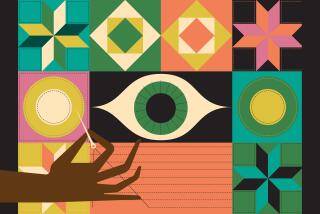Weaving New Life Into a Lost Art
The quickness of their fingers on the loom, with small knives flashing, mesmerizes the dozen spectators gathered at the Woven Legends carpet gallery on Montana Avenue in Santa Monica. Two Turkish women are showing how to weave a knotted pile rug. They tie small pieces of yarn, dyed with natural recipes used by hundreds of generations of their ancestors, to the rug’s foundation and then snip them with the knife, all in the blink of an eye.
Tying “symmetrical”--or Turkish--knots, the weavers are following a tradition that dates back 25 centuries to the oldest Oriental rug ever discovered, the famed Pazyryk carpet. It’s a tradition that was “murdered” during the 20th century, George Jevremovic, founder of the Philadelphia-based rug producer Woven Legends, tells the crowd. Politics, war, and particularly technology--via inexpensive chemical dyes and machine-spun wool--destroyed traditional weaving.
Today, these weavers and thousands more throughout Asia are turning back the clock and reviving the ancient art of producing Oriental carpets using natural dyes and hand-spun wool, says Jevremovic.
The 43-year-old American should know. He gets much of the credit for igniting the revival. Starting in rural Turkey with the launch of Woven Legends in 1981, Jevremovic has been organizing village sheepherders, wool spinners, dyers and weavers to produce new Oriental carpets, which he then sells in America and Europe.
“Jevremovic was the first,” says Emmett Eiland. In his book “Oriental Rugs Today, a Guide to the Best in New Carpets From the East” (Berkeley Hills Books, 2000), Eiland calls it a “renaissance” in which weavers have rediscovered materials and designs that seemed lost forever.
Jevremovic’s Woven Legends and then later his Black Mountain Looms, a joint venture launched in 1989 with New York’s Michaelian & Kohlberg, now collectively employ more than 30,000 people, Jevremovic says, producing an average of 2,000 new Oriental carpets a month in Turkey, India and China. Jevremovic’s firms bring in nearly $15 million in annual sales.
According to Hali, the international textile journal published in London, Jevremovic’s operations have grown “from being niche market players to leading manufacturers and wholesalers” and in the process have “provided the benchmark by which all contemporary production is judged.”
Sporting black jeans, a dark sport coat and shirt with open collar for his lecture to the 30 rug aficionados gathered in Santa Monica, the youthful-looking Jevremovic says he was “bitten by the rug bug,” on his first journey to Turkey, in 1978. He made the trip following his then-girlfriend home to her native Turkey. She later became his wife, and although they have since divorced, Neslihan Jevremovic remains his business partner in Woven Legends.
In 1982, a new rug in an Istanbul shop window changed his life. Unlike the chemical colors in other new rugs that tend to be bright and shiny, the carpet he discovered had the deep, rich flavor of a 100-year-old rug. At the time, Jevremovic says, common wisdom was “that the people who made those highly valued, sacred rugs in the 1800s were all dead and that the craft had died with them.” Indeed, during most of the 20th century, because machine-spun yarn and chemical dyes could be ordered simply and cheaply, the weaving way of life--with pastoral nomads and villagers producing wool and dyes for the rugs they wove--had become a dim memory.
But the carpet that transfixed Jevremovic that day was woven in a small village using natural dyes--such as milkweed for yellow, madder root for red, indigo for blue, walnut for black. The ancient dye recipes, carefully guarded secrets dead for several generations, had been decoded in the mid-1970s by a German chemist named Harald Bohmer. Bohmer had persuaded the Turkish government to sponsor a project reviving these traditional materials in former weaving areas.
So began Jevremovic’s quest: “We are going to make rugs that everyone said it was impossible to produce.” He quickly discovered that “there were no wool experts anywhere. I would travel around with pieces of old yarn from antique rugs, but no one could tell me how to re-create them.”
Jevremovic knew that the key to reviving the art involved natural dyes, hand-spun wool and inspired weavers. Jevremovic spent nearly five years before the labor began to bear fruit. In mountainous, rural southeastern Turkey, Jevremovic found enough weavers to begin new carpet production, and, as important, plenty of “fat-tailed” sheep to provide the right kind of wool.
“Knitting is what saved us,” says Jevremovic. Many village women also were knitting yarn they had spun by hand from raw wool. Jevremovic began the process of organizing hundreds--and eventually thousands--of these women to hand-spin the wool into yarn and later to weave the carpets.
At the same time, Jevremovic set up dyeing operations, re-creating the ancient colors using Bohmer’s recipes at first and then expanding the palette to more than 100 colors.
“What was so impressive about what George did,” notes author Eiland, “is that he had to create an entire infrastructure where none existed, in the difficult conditions of rural Turkey.” Jevremovic, who is American and was raised in Ohio and New York, likens the area to Appalachia--poor, agricultural people in underpopulated villages, linked by mountainous dirt roads, lacking communications, and often snowbound in winter.
He also needed buildings to house large looms. Village houses were too small for the looms to weave the 6-by-9-foot carpets popular in Western homes, let alone the 9-by-12-foot ones.
Calling on provincial governors in looking for unused buildings, Jevremovic dreamed of “ateliers,” artists studios where weavers would share ideas and technique. Frequently, he was dismissed with “Who are you to tell us about making Turkish rugs?”
Eventually, in Adiyaman, a village in eastern Turkey, 350 miles from the Iranian border, Jevremovic found a cooperative and supportive governor who gave the entrepreneur permission to use some vacant public buildings. Jevremovic convinced the weavers that they could support themselves making rugs by agreeing to purchase all their output, regardless of how it turned out. Woven Legends currently has 200 ateliers in Turkey in 120 towns and villages.
Weavers are paid per square-foot, with full-time workers averaging about $200 per month, which in a rural mountainous village is considered significant. But most importantly for Jevremovic, village people now have a source of income that can sustain them, allowing them to stay in the village instead of moving away to find work.
Designing Carpets
That Have Soul
One final element remained unresolved: design. To make enduring rugs, he wanted his weavers “to be creative, to innovate and contribute to the designs, to make carpets with soul”--the way their ancestors had. He did not want any two rugs to look alike. But he also knew that certain designs would be more marketable than others.
Old rugs--Persian Bakshaish and Turkish patterns from the 19th century--were his models.
In their authenticity, however, some antique-rug traders and enthusiasts increasingly are fooled by such new rugs. “Let’s see a few years go by. These rugs are going to look just like antique carpets,” says one L.A. carpet expert. “Only really knowledgeable people will be able to tell the old from the new.”
In addition, to satisfy customers who want antique-looking rugs, Jevremovic and others also make reproductions to order that include areas that are deliberately damaged then repaired, to make them look old. Even experienced eyes have been fooled.
Says Eiland in his book: “I venture to say that not a single carpet was made in the world from 1930 to 1985 as good as any of [Jevremovic’s] Mahindras.” And though a 19th century 8-by-10 might fetch anywhere from $10,000 to $50,000, or even more--depending on its age and condition--Jevremovic’s new rugs of comparable size cost $5,000 to $6,000 at one of his 50 U.S. dealers.
For now, Jevremovic’s pioneering efforts have spawned more competition than ever, as other producers have set up traditional rug-making operations in Pakistan, where thousands of expert weavers from Afghanistan live as refugees. India and China are also areas where production has increased dramatically during the past decade. And now that the embargo against importing Iranian carpets was lifted a year ago, new Iranian carpets are also appearing. Still, according to Eiland, only a small percentage of these other new carpets are high-quality.
“I entered a vacuum,” says Jevremovic, “and for nearly seven years we had no competition.”


